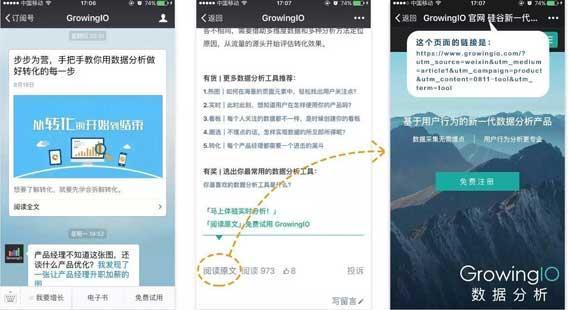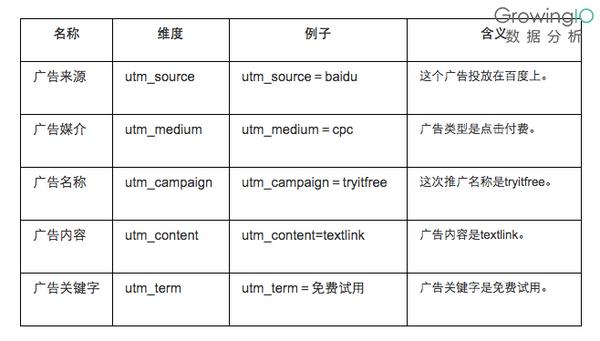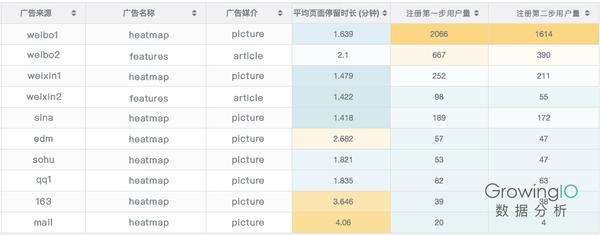本文主要是介绍UTM(Urchin Tracking Module)简介,希望对大家解决编程问题提供一定的参考价值,需要的开发者们随着小编来一起学习吧!
#
UTM是 “Urchin Tracking Module”的简写,大意就是跟踪模块。【2】
#
URL链接每个参数的详细信息和示例参考:
#
广告系列来源(utm_source)
必填属性。使用 utm_source 来标识搜索引擎、简报名称或其他来源。示例:utm_source=google
#
广告系列媒介(utm_medium)
必填属性。使用 utm_medium 来标识媒介,比如电子邮件或每次点击费用。示例:utm_medium=cpc
#
广告系列字词(utm_term)
用于付费搜索。使用utm_term来注明此广告的关键字。示例:utm_term=running+shoes
#
广告系列内容 (utm_content)
用于A/B测试和按内容进行定位的广告。使用utm_content区分指向同一网址的广告或链接。示例:utm_content=logolink或utm_content=textlink
#
广告系列名称(utm_campaign)
用于关键字分析。使用utm_campaign来标识特定的产品促销活动或战略性广告系列。示例:utm_campaign=spring_sale
#
You see it all the time in news stories you click into from Facebook, your email inbox, and many other popular places where you hang out. It’s a long string attached to the end of the page’s address that looks something like this: “utm_source=facebook&utm_medium=fanpage&utm_campaign=new+article&wa_ibsrc=fanpage.” It seems to be popping up more frequently, and has been an annoyance for many. What’s it used for? Should you be worried about the implications of this? Is it a form of tracking? We’ll have a look at what UTM is and answer any question you might have on this subject.
What Is It?
![]()
UTM stood for the Urchin Traffic Monitor, which was part of a software called “Urchin WebAnalytics Software” released in 1998. Google eventually purchased its technology in 2005 and sold the software for almost seven years until it was discontinued in March 28, 2012. Although it’s no longer selling, Google continues to use its URL conventions in its own analytics software to create campaigns, hence the “utm” in “utm_source” and many other variables. Simply put, the “utm” variables are tracking mechanisms that help companies gauge on how successful their campaigns are.
The Purpose of UTM Trackers
So, when a company is using UTM trackers (also abbreviated UTM, which is short for “Urchin Tracking Module”), you’ll click on a link that leads to a long address like the one I mentioned in the introduction. If you remove all the UTM variables, you still arrive at the same page. The only difference is that they won’t know where you’re coming from. Companies have to know whether the campaigns they invest time and money into are actually getting you to click on their links. It’s a way to help cut expenses where they’re not necessary and further experiment with ways of attracting new audiences.
The most common variables for UTM trackers are “source” and “medium.” The “utm_source” tells a company what site the link originally came from, and the “utm_medium” tells the company what original medium was used to send the link (i.e. referral, email, instant message, etc.).
Should You Be Worried?
UTM trackers are not to be mistaken with tracking cookies. They don’t track your activity all over the Internet. They simply show what campaign attracted you to click on a particular link. The danger level here is extremely low. While you might be wary of anything that tracks you, UTM trackers don’t download anything to your computer like tracking cookies do.
So, if you’re afraid of privacy infringement, there really is nothing to worry about with UTM trackers. They’re friendly pieces of code used for marketing purposes. The only thing that could worry you, though, is the fact that the link shows where you came from to get to the page it links to.
If you’re still worried and want to get rid of them, you can download a tracking token remover for either Mozilla Firefox or Google Chrome.
Conclusion
As long as you click links on websites that you trust, you should be fine. Even on websites you don’t trust, UTM trackers present no opportunity to harm you in any way. In fact, if you have a site, you might want to use these to determine what’s working out for you and what’s just wasting your time. If you have other thoughts on this, leave a comment below!
参考:https://www.zhihu.com/question/48724061
链接:https://www.zhihu.com/question/48724061/answer/122730629
来源:知乎
著作权归作者所有。商业转载请联系作者获得授权,非商业转载请注明出处。
在这里详细介绍下 UTM 的使用和含义。
UTM 除了最基础的追踪流量来源外,还可以根据不同渠道、不同内容做精细化运营分析,帮你对比区分优质和劣质渠道,提高流量在产品内的转化。
先来看一个结果:添加 UTM 参数的链接的链接投放后,我们就可以看到这样的统计了:<img src="https://pic4.zhimg.com/4a97c5556403190d36124b826b4c454b_b.jpg" data-rawwidth="1063" data-rawheight="415" class="origin_image zh-lightbox-thumb" width="1063" data-original="https://pic4.zhimg.com/4a97c5556403190d36124b826b4c454b_r.jpg">

每一个渠道带来的流量都十分清晰,用户在产品内的行为也一目了然,是否注册了,是否最终购买了,都可以看到。我们可以看到讲述 heatmap 热图的这篇内容在渠道「微博 1」投放的链接,带来了 9992 个页面浏览量,2066 个注册用户量,以及 1614 个购买用户量。
而且不仅可以看到同一篇文章在不同渠道的流量情况,如 heatmap 热图这篇内容在微信、微博和其他渠道的推广情况;还可以看到同一个渠道不同文章带来的流量情况,如在微博渠道,heatmap 热图的文章的导流情况比 features 功能文章的导流情况更好。
用户在产品内的行为,有多少进行了注册,有多少完成了购买,清清楚楚,而且,我们还可以将不同渠道进行分组,查看不同渠道的用户留存和转化。
那么,我们先来看下,这样的 UTM 参数是怎样设置的呢?
Part 1 | UTM 参数的设置
通过 UTM 参数追踪外部流量的访问情况的原理是:把你投放在不同渠道的链接打上特定的标记,以监控各个链接的流量情况。
1. 确定目标链接
首先,确定这个链接最终指向的目标网页是哪个?一般来说是你自己的网站的某个页面,然后这个页面需要加载过数据统计分析工具的 SDK 。举个例子,如果使用 GrowingIO 进行接下来的拆解分析,就需要这个页面是加载过 Growing JS 代码的网址。不要以为在别人网站的链接后加上 UTM 参数,你就可以看到别人网站的点击情况了,这一切的前提是,链接最终指向加载了相应的分析代码的你自己的网站。
2. 添加自定义的参数
接下来,我们需要设置 UTM 的参数,也就是在链接上添加规则,进行标记,投放链接后我们就可以知道是哪个来源带来的流量了。对于不同的活动或文章,我们要设置不同的 UTM 参数用来区分。
说白了,这里就是你用各种各样的内容来描述这条链接是放在哪个活动、哪个来源上的,我们来看一个例子进行理解。

以现在很常用的新媒体营销方式为例,我们在微信的阅读原文里放了一条引导流量的链接:
https://www.growingio.com/?utm_source=zhihu&utm_medium=article&utm_campaign=product&utm_content=0811-tool&utm_term=tool
- https://www.growingio.com/ 这条链接最终指向的地址;
- utm_source=zhihu 投放的渠道是知乎;
- utm_medium=article 媒介是一篇文章;
- utm_campaign=product 这篇文章是产品介绍系列的;
- utm_content=0811-tool 文章内容是「8.11 编辑,介绍工具」;
- utm_term=tool 文章的关键词是「tool」;
你一定会问,这个 URL “ ? ” 之后的参数都是什么?简单说,可以把 “ ? ” 之后的 UTM 参数理解为链接的名字,即为投放在不同渠道的每个链接起的分析工具能够识别的名字。
我们把这些信息连起来,这条 UTM 代表的含义就是:这个指向 http://www.growingio.com/ 的投放链接,是在 8 月 11 日 utm_content=0811-tool,知乎 utm_source=zhihu 的文章里 utm_medium=article 投放的,这篇文章是介绍工具 utm_term=tool 的产品文章 utm_campaign=product 。
当你在数据分析工具里做分析时,就可以像破解密码一样读出它的意思了,知道它放在了哪个内容里,用在了哪个活动里。
当我们有很多内容同时在各个渠道投放时,这样的链接就十分有用了,我们知道每个渠道每条内容带来的流量,也可以按照不同的渠道将流量进行分组,分析不同渠道带量的效果和质量。
我们提供的 UTM 参数和自定义参数的方式采用的是目前市面上最常用的定义方式:
<img src="https://pic1.zhimg.com/53be54fc398bdf52c97b7c77fdef6b54_b.jpg" data-rawwidth="649" data-rawheight="320" class="origin_image zh-lightbox-thumb" width="649" data-original="https://pic1.zhimg.com/53be54fc398bdf52c97b7c77fdef6b54_r.jpg">
我们可以根据需要,进行各种各样自定义的填充,因为 UTM 最初是用在广告监控上的,所以它的很多名称还是关于广告的,但是我们现在已经可以把它放在各个内容、活动、推广中,监控渠道的流量情况。
具体的填写参数的意义和方法,可以根据下面这些情景进行灵活的变通。
1. 当这条链接用于付费推广时,可以这样定义:
<img src="https://pic3.zhimg.com/457a27ca5b2aceb7b8003a8f91f95e06_b.jpg" data-rawwidth="658" data-rawheight="374" class="origin_image zh-lightbox-thumb" width="658" data-original="https://pic3.zhimg.com/457a27ca5b2aceb7b8003a8f91f95e06_r.jpg">
2. 当这条链接用于内容文章时,可以这样定义:
<img src="https://pic4.zhimg.com/5f2af1e60a8a94bd9df0ff23a0026db3_b.png" data-rawwidth="600" data-rawheight="296" class="origin_image zh-lightbox-thumb" width="600" data-original="https://pic4.zhimg.com/5f2af1e60a8a94bd9df0ff23a0026db3_r.png">
3. 当这条链接用于活动时,可以这样定义:
<img src="https://pic4.zhimg.com/aaee8514c40384b1fb4761b96c117a27_b.png" data-rawwidth="584" data-rawheight="320" class="origin_image zh-lightbox-thumb" width="584" data-original="https://pic4.zhimg.com/aaee8514c40384b1fb4761b96c117a27_r.png">
如果是你自己看这个数据,只要设置你能看懂的内容就可以,涉及到团队协作时,最好统一下标准,以便后续的数据分析。
Part 2 | UTM使用的案例
UTM 做好了之后,可以做哪些分析呢?我们就可以进行日常的监控和活动的监控了。
现在,我们知道哪些投放的渠道来的量高、哪些量低了,可以有的放矢地进行市场推广和渠道运营,我们可以用 UTM 里面的维度来制图,看一下这一周文章投放的效果:
<img src="https://pic1.zhimg.com/235999524bc591a9cef6f9bdfd60703c_b.jpg" data-rawwidth="843" data-rawheight="415" class="origin_image zh-lightbox-thumb" width="843" data-original="https://pic1.zhimg.com/235999524bc591a9cef6f9bdfd60703c_r.jpg">
接下来,你可能想了解更多细节,这些人都访问了哪些页面呢?比如说他们是否最终注册完成了呢?我们可以加上注册页面的指标来做图:
<img src="https://pic2.zhimg.com/8c4cdaf08d3bde47f3101e395e0deca5_b.jpg" data-rawwidth="1061" data-rawheight="415" class="origin_image zh-lightbox-thumb" width="1061" data-original="https://pic2.zhimg.com/8c4cdaf08d3bde47f3101e395e0deca5_r.jpg">
这些都只是一个开始,接下来我们还可以做更有价值的数据分析,在漏斗里,用UTM参数作为不同的维度,可以对比不同来源不同内容的转化率:
<img src="https://pic4.zhimg.com/832f3ffac07d108828142e07d1967e67_b.jpg" data-rawwidth="1109" data-rawheight="633" class="origin_image zh-lightbox-thumb" width="1109" data-original="https://pic4.zhimg.com/832f3ffac07d108828142e07d1967e67_r.jpg">
借助 UTM,可以把流量来源、转化、ROI 都分析清楚。
这篇关于UTM(Urchin Tracking Module)简介的文章就介绍到这儿,希望我们推荐的文章对编程师们有所帮助!






